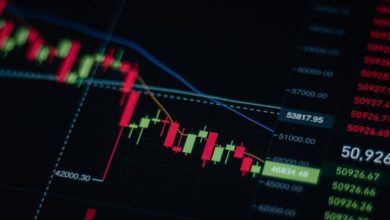How NFT Market Trends Are Influencing the Broader Crypto Space

- The Impact of NFTs on Crypto Prices
- Exploring the Connection Between NFT Sales and Bitcoin’s Value
- NFTs as a Driver for Innovation in the Cryptocurrency Industry
- The Rise of NFT Marketplaces and Their Effect on Crypto Adoption
- Analyzing the Relationship Between NFT Hype and Altcoin Performance
- How NFT Collectibles Are Reshaping the Digital Asset Landscape
The Impact of NFTs on Crypto Prices
NFTs have had a significant impact on the broader crypto space, influencing the prices of various cryptocurrencies. The rise of NFTs has brought a new level of interest and investment into the crypto market, leading to fluctuations in prices across the board.
One of the key ways in which NFTs have influenced crypto prices is through the creation of value for unique digital assets. These non-fungible tokens have opened up a new market for digital art, collectibles, and other unique items, driving up demand for cryptocurrencies that are used to purchase them.
Additionally, the popularity of NFTs has attracted new investors to the crypto space, leading to increased trading volumes and liquidity. This influx of new capital has had a direct impact on the prices of cryptocurrencies, as demand for these digital assets has surged.
Moreover, the success of NFT projects has also had a spillover effect on the broader crypto market, with investors looking to diversify their portfolios by investing in both NFTs and traditional cryptocurrencies. This has helped to create a more interconnected ecosystem within the crypto space, driving up prices across the board.
Overall, the impact of NFTs on crypto prices cannot be understated. As the NFT market continues to grow and evolve, it will likely have an even greater influence on the broader crypto space, shaping the future of digital assets and investment opportunities.
Exploring the Connection Between NFT Sales and Bitcoin’s Value
Exploring the connection between non-fungible token (NFT) sales and Bitcoin’s value can provide valuable insights into the broader cryptocurrency space. NFTs have been gaining popularity in recent years, with artists, musicians, and creators selling digital assets on various platforms. As the demand for NFTs increases, so does the interest in cryptocurrencies like Bitcoin.
One way in which NFT sales can influence Bitcoin’s value is through the flow of capital between the two markets. When investors purchase NFTs, they often use cryptocurrencies like Bitcoin to make their purchases. This can lead to increased trading volume and liquidity in the Bitcoin market, which in turn can impact its price.
Additionally, the success of NFT sales can serve as a barometer for the overall health of the cryptocurrency market. If NFT sales are booming, it may indicate increased investor confidence and interest in digital assets, including Bitcoin. Conversely, a decline in NFT sales could signal a potential downturn in the broader cryptocurrency space.
Overall, monitoring the trends in NFT sales and their impact on Bitcoin’s value can provide valuable insights for investors and enthusiasts alike. By understanding the connection between these two markets, individuals can make more informed decisions when navigating the ever-changing landscape of cryptocurrencies.
NFTs as a Driver for Innovation in the Cryptocurrency Industry
NFTs have emerged as a significant driver for innovation within the broader cryptocurrency industry. These unique digital assets have revolutionized the way we perceive ownership and authenticity in the digital space. By leveraging blockchain technology, NFTs provide a secure and transparent way to buy, sell, and trade digital assets.
One of the key ways in which NFTs are influencing the broader crypto space is through the creation of new market trends and opportunities. NFTs have opened up a whole new world of possibilities for artists, creators, and collectors to monetize and showcase their work in ways that were previously not possible. This has led to an explosion of creativity and innovation within the NFT ecosystem.
Furthermore, the rise of NFTs has sparked a wave of interest and investment in blockchain technology and cryptocurrencies as a whole. NFT market trends have attracted mainstream attention and have brought new participants into the crypto space. This increased interest and participation have led to a surge in technological advancements and developments within the industry.
The Rise of NFT Marketplaces and Their Effect on Crypto Adoption
The rise of NFT marketplaces has had a significant impact on the broader crypto space in recent years. Non-fungible tokens, or NFTs, have gained popularity as a new way to buy, sell, and trade digital assets. This trend has led to the emergence of various NFT marketplaces where users can purchase and sell NFTs using cryptocurrencies.
One of the key effects of the rise of NFT marketplaces is the increased adoption of cryptocurrencies. As more people participate in NFT transactions, they are exposed to the world of cryptocurrencies and blockchain technology. This exposure has led to a growing interest in cryptocurrencies as a whole, driving more people to invest in and use digital assets.
Moreover, the emergence of NFT marketplaces has created new opportunities for artists, creators, and collectors to monetize their work. By tokenizing digital assets as NFTs, creators can sell their work directly to buyers without the need for intermediaries. This has revolutionized the way artists can profit from their art and has opened up new revenue streams for creators in various industries.
In addition, the popularity of NFT marketplaces has led to increased innovation in the crypto space. Developers are constantly creating new platforms and tools to support the buying, selling, and trading of NFTs. This innovation has not only improved the user experience on existing NFT marketplaces but has also led to the development of new decentralized applications and protocols that are pushing the boundaries of what is possible with NFTs.
Overall, the rise of NFT marketplaces is reshaping the crypto space by increasing adoption, creating new opportunities for creators, and driving innovation in the industry. As NFTs continue to gain traction, we can expect to see even more growth and development in the broader crypto space in the coming years.
Analyzing the Relationship Between NFT Hype and Altcoin Performance
One interesting aspect to consider when analyzing the current NFT market trends is the relationship between the hype surrounding NFTs and the performance of altcoins. Altcoins are cryptocurrencies other than Bitcoin, and they often experience price movements that correlate with market sentiment and trends in the broader crypto space. As NFTs have gained popularity and captured the attention of mainstream media and investors, we have seen a notable impact on the performance of altcoins.
Many altcoins have seen significant price increases as a result of the increased interest in NFTs. This can be attributed to several factors, including the fact that NFTs are typically bought and sold using cryptocurrencies, leading to increased demand for altcoins. Additionally, the excitement surrounding NFTs has spilled over into the broader crypto market, driving up prices across the board.
However, it’s essential to note that the relationship between NFT hype and altcoin performance is not always straightforward. While some altcoins may benefit from the NFT craze, others may not see the same level of price appreciation. Factors such as the underlying technology of the altcoin, its use case, and market dynamics can all play a role in determining how it will perform in response to NFT trends.
How NFT Collectibles Are Reshaping the Digital Asset Landscape
NFT collectibles have been making waves in the digital asset landscape, revolutionizing the way we perceive and interact with digital art and other virtual assets. These non-fungible tokens have opened up new possibilities for creators and collectors alike, allowing for unique, verifiable ownership of digital assets. As a result, the NFT market has seen unprecedented growth in recent years, with high-profile sales capturing the attention of the mainstream media and attracting a diverse range of participants.
One of the key ways in which NFT collectibles are reshaping the digital asset landscape is by introducing a new level of scarcity and exclusivity to the world of digital art and other virtual assets. Unlike traditional cryptocurrencies, which are fungible and can be exchanged on a one-to-one basis, NFTs are unique and indivisible, making them ideal for representing one-of-a-kind digital assets such as artwork, music, and even virtual real estate. This scarcity has driven up demand for NFT collectibles, with some pieces selling for millions of dollars at auction.
Another important impact of NFT collectibles on the digital asset landscape is their ability to provide creators with new ways to monetize their work. By tokenizing their art or other digital assets as NFTs, creators can sell limited editions or even single copies of their work directly to collectors, cutting out the middlemen and retaining more control over their creations. This has empowered artists, musicians, and other creators to reach new audiences and generate income in ways that were previously impossible in the digital realm.
Overall, the rise of NFT collectibles is reshaping the digital asset landscape in profound and exciting ways, opening up new opportunities for creators, collectors, and investors alike. As the NFT market continues to evolve and mature, we can expect to see even more innovations and disruptions that will further transform the way we interact with and value digital assets.



